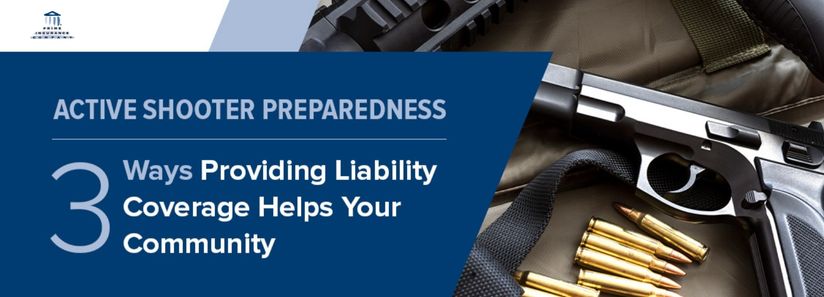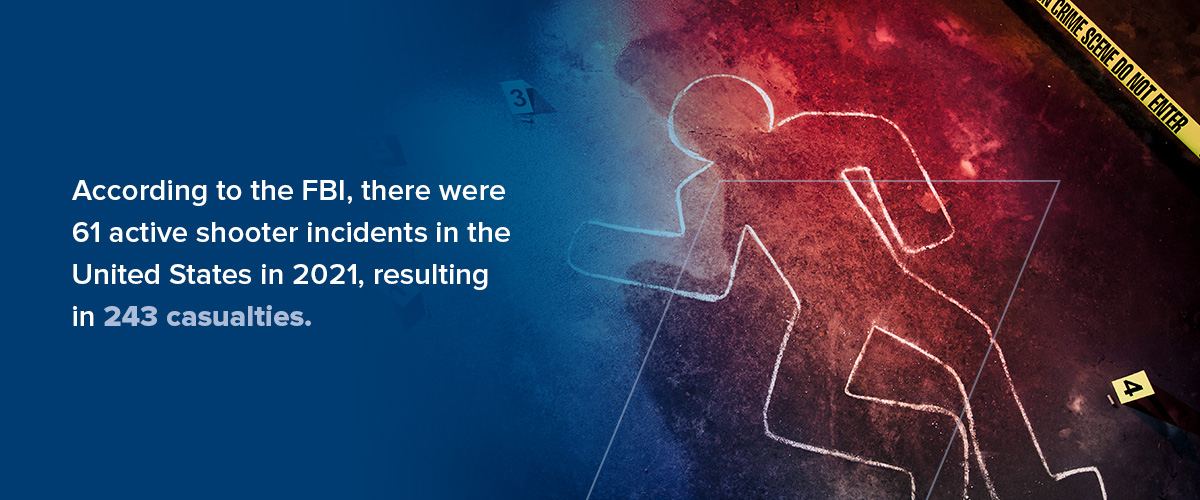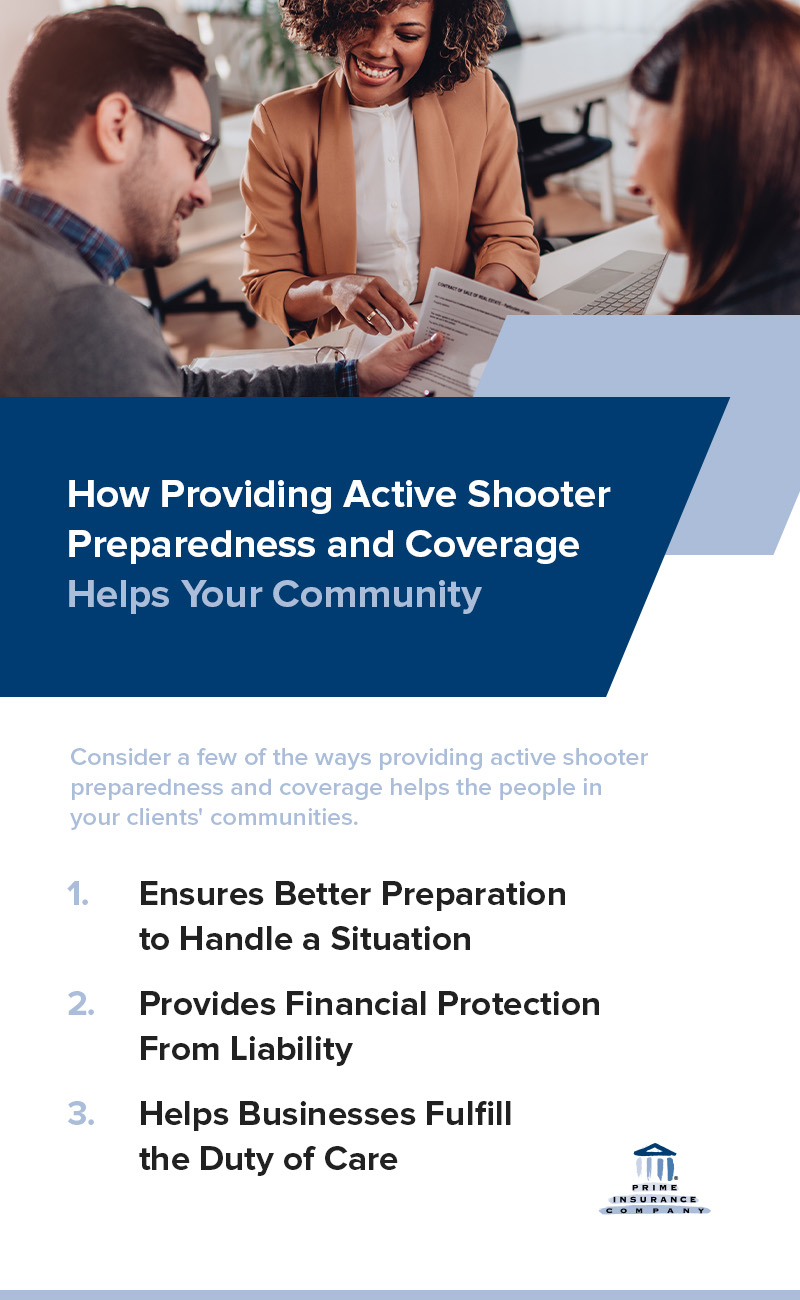Active shooter incidents can occur in workplaces, schools, entertainment events and other public places. The harm and loss of human life these tragedies cause are devastating to families and communities. While less observable, the financial damage an institution can experience from an active shooting incident is just as real.
Insurance producers can help their clients and communities protect themselves against active shooters by offering active shooter liability insurance. This kind of insurance helps organizations protect their assets in an active shooter incident. As an insurance producer, you may have clients at risk of an active shooter incident occurring on or near their business property. Consider the benefits of active shooter insurance for your clients.
What Is an Active Shooter?
According to the FBI’s definition of an active shooter incident, the situation is when one or more people actively kill or attempt to kill others in a populated area using a firearm. In these instances, the shooter targets multiple people and the incident is ongoing, meaning that the speed of the emergency response can affect the outcome.
However, not all kinds of gun-related violence are considered active shootings. The FBI’s parameters for determining whether an event is an active shooter incident include shootings that:
- Occurred in public places
- Appeared spontaneous
- Appeared as if the shooter intentionally searched for potential victims
- Occurred in multiple locations
- Did not result from another criminal act
- Resulted in a mass killing
- Targeted people rather than objects or buildings
The FBI excludes the following types of shootings from the definition:
- Self-defense
- Drug violence
- Gang violence
- Contained domestic or residential disputes
- Crossfire resulting from another criminal act
- Controlled hostage situations
- Shooting that appears not to have endangered others
Active shooter incidents have escalated in recent years. According to the FBI, there were 61 active shooter incidents in the United States in 2021, resulting in 243 casualties. These figures are up from 30 incidents with 164 casualties in 2019. Of the 61 incidents in 2021, 12 incidents met the FBI’s definition of mass shootings — up from only five in 2020.
Active shooter incidents can occur in any location, although the FBI’s report indicates that areas of commerce are the most common, with open spaces following. Of the 61 shooters that carried out the 61 incidents in 2021, 15 had past or present relationships with the institution.
The Importance of Active Shooter Preparation
While active shooter incidents are relatively uncommon and may be preventable in many instances, they can devastate families and entire communities. Understandably, many businesses and organizations search for ways to prepare for such incidents with active shooter drills and other security measures. These strategies can effectively prevent or mitigate the risk of an active shooting incident.
However, these methods alone do little to prepare for a business’s recovery from such an incident after it occurs. Comprehensive preparation for an active shooter involves creating strategies for preventing, responding to and recovering from these incidents.
Thorough active shooter preparation can:
1. Protect Community Members
Businesses and institutions can more effectively protect employees, customers, students and other at-risk community members when they prepare for active shooter incidents. These incidents usually happen without warning, so businesses can’t predict when or how they will occur. However, organizations can use several strategies to prepare in advance and give the people in their communities a chance at a better outcome.
Law enforcement is the primary mechanism for protecting community members, yet businesses and institutions can also help. The FBI’s active shooter incident report found that of the 61 incidents in 2021, six included involvement from citizens or employees in which a citizen or employee shot, tackled or disarmed the shooter. A preparedness plan can help businesses give their employees the tools to handle these incidents.
2. Prepare Response Teams
Creating a response plan is essential in preparing for an active shooter incident. When businesses develop a thorough response plan, they can outline the best course of action and educate their employees on when to hide, run or engage the shooter.
Response teams are vital to any emergency response plan and can quickly react to suspicious activity or an active shooter incident to mitigate the threat. Notifying law enforcement and other emergency responders should always be the first response. In addition, it is helpful to train employees on how to initiate lockdown procedures, alert others of evacuation routes and react to encountering an active shooter.
This internal response team can positively impact the situation’s outcome while law enforcement arrives at the scene. When creating a response team, organizations can consider factors like which people are in the best position to respond in an emergency.
3. Help Businesses Recover
Another aspect of active shooter preparedness is preparing for recovery. If the families or victims of an active shooter incident feel the business didn’t do enough to prevent or mitigate an incident, they may file a lawsuit. Institutions could also be held liable for medical bills, funeral expenses and more.
To financially prepare for the event of an active shooter, organizations should consider active shooter liability insurance. With active shooter insurance, businesses can have peace of mind about their coverage and reduce liability. Organizations may also benefit from claims handling as part of their coverage plan.
Methods and Strategies for Preparation
Active shooter preparedness is crucial for responding to these situations in the best way possible. There are five main areas of active shooter preparedness for organizations to implement in their preparedness plan. Consider these strategies when creating your active shooter preparedness checklist.
1. Prevent
Prevention consists of an organization’s steps to stop, deter or avoid potential threats. Even the most robust safety and security plans can’t prevent every active shooter incident — however, businesses can take several steps to reduce the likelihood of these incidents.
There are a few options for institutions to help prevent active shooter incidents:
- Conduct background checks: Screening job candidates before hiring can help organizations check for individuals that might engage in violent behaviors.
- Improve work environment: Promoting a positive workplace where employees treat each other with respect and compassion might curtail aggressive behaviors that could lead to an active shooter incident.
- Invest in employees: Many employees can benefit from having access to mental health counseling during difficult periods of life.
- Create a reporting system for suspicious activity: Individuals may exhibit several red flag behaviors before planning an attack, including a sudden decline in mental health, increase in illicit drug use, paranoia or fascination with mass shootings.
2. Protect
Protection measures are ongoing activities businesses can plan to safeguard their employees, visitors and customers. These strategies can include:
- Developing active shooter preparedness training: Businesses should develop an active shooter preparedness program and enforce training for all employees. Active shooter preparedness training educates staff on the appropriate steps to take when responding to an active shooter incident. The Federal Emergency Management Agency (FEMA) has also created an online training course that helps participants recognize potential violence indicators and respond to an active shooter.
- Establishing an emergency communication system: Employees and staff should be able to communicate with one another and law enforcement in the event of an active shooter incident. Businesses may use an intercom system to communicate rapidly throughout the building.
3. Mitigate
Mitigation is the process of detecting an escalating threat and limiting the damage. Organizations and employees can take several steps to reduce the likelihood of an active shooter incident and lessen the impact if one does occur.
First, a threat assessment can help organizations discover the particular threats their employees might encounter. Threat assessments identify risks and provide a road map for developing solutions. Active monitoring through security cameras and physical security teams also allow businesses to identify threats and quickly respond.
4. Respond
When an active shooter incident occurs, the speed and effectiveness of the response are critical to the outcome. An organization must respond quickly to stabilize a situation and restore safety. An effective response strategy should include the following:
- Communicating with employees: Businesses should have trained employees to respond to an active shooter situation. When an incident occurs, they need a method for alerting employees and others within the building to the situation. Businesses should empower employees to sound an emergency alarm in case of an emergency that alerts first responders, employees and visitors. This strategy can help people get to safety and potentially save lives.
- Implementing training: Employees must put their active shooter preparedness training into practice. People can take three potential actions in an active shooter scenario — run away from the situation, hide in a safe place or fight the active shooter. People should attempt the first two actions and only engage an active shooter if forced to do so.
5. Recover
The recovery process is the phase in which businesses restore the environment and help their people return to regular operations. Institutions should prioritize communication in this step to alert employees about resolutions and support they are offering. Recovery involves healing in four aspects:
- Physical: Some employees may have physical wounds that need time to heal.
- Psychological: Businesses can help employees heal emotionally by offering support through trained counselors.
- Services: Active shooter incidents could result in an interruption of business, and returning to regular operations is a part of recovery.
- Financial: Financial recovery can be easier with active shooter liability insurance that covers certain costs of these tragic events.
How Providing Active Shooter Preparedness and Coverage Helps Your Community
Preparation is essential to handling active shooter incidents effectively. Active shooter liability insurance is one of the best ways businesses can protect their assets and financially recover. This kind of insurance enhances a business’s or organization’s third-party liability insurance to cover injuries and damages for which a business is legally responsible after an active shooter incident.
As an insurance producer, offering active shooter liability coverage can be challenging. Many insurance carriers don’t provide active shooter insurance because of the high risk. However, Prime Insurance Company offers Active Shooter Liability Coverage as a policy enhancement to an existing Company Commercial Liability policy. By offering Prime’s coverage to your clients, you provide them with peace of mind and a policy that protects their assets in the event of a tragedy.
Businesses with active shooter insurance gain several benefits. Consider a few of the ways providing active shooter preparedness and coverage helps the people in your clients’ communities.
1. Ensures Better Preparation to Handle a Situation
Active shooter incidents escalate quickly. Organizations should prepare to protect their people and promote the best outcome. Creating a response plan and training employees on the run, hide, fight protocol can help. Practicing drills can also prepare employees to react quickly and apply what they learned in training.
The last thing an organization needs to consider during an active shooter incident is whether its insurance policy will cover potential injuries to employees or visitors. With active shooter liability insurance, businesses and organizations are more prepared to handle these incidents swiftly. Active shooter insurance is the coverage businesses need to protect their assets and people and recover faster.
Obtaining this type of coverage is one step businesses can take to ensure they protect themselves and their employees in case of an incident. When institutions know they have the necessary coverage, they can train employees and respond to emergencies more confidently.
2. Provides Financial Protection From Liability
Besides the risk of physical harm to employees and visitors, active shooter incidents pose significant financial threats to organizations and victims. The cost of an active shooter incident can include legal fees, medical bills, judgments and settlements. It can be challenging for businesses to recover from costly judgments, and even settlements can be expensive. Unprotected companies with gaps in their liability coverage may be financially unprepared to handle these incidents.
Active shooter liability insurance provides a financial safeguard against injuries and damages. This kind of coverage limits a business’s liability and can help cover the cost of some injuries and damages related to the incident.
3. Helps Businesses Fulfill the Duty of Care
Under United States law, employers are responsible for providing for the safety and health of employees, called the duty of care. The duty of care includes the obligation to protect against workplace violence. If a court finds bad faith or gross negligence in how a business made decisions, the institution could be liable for damages. With active shooter incidents rising, many businesses see providing coverage as part of their duty of care.
As an insurance producer, you can support your clients and their communities by offering active shooter liability coverage customized to business needs. Prime offers flexible policies designed to help businesses protect their people and operate in good faith that they have adequately prepared for an active shooter incident.
Contact Prime Insurance Company for Active Shooter Liability Insurance
Active shooter incidents are unpredictable. Fortunately, businesses can take several steps to prepare themselves and their employees for potential incidents and improve their outcomes. As an insurance producer, providing active shooter liability coverage for your clients can help you serve more businesses in need of insurance.
At Prime Insurance Company, we work directly with insurance producers to offer active shooter liability insurance for businesses that otherwise go uninsured or have to self-insure. As an excess and surplus lines insurance carrier, we can provide unique insurance solutions for hard-to-place risks like active shooter incidents. We are rated “A” (Excellent) by AM Best* and have been in business for over 40 years. Our in-house underwriting and risk management teams work with policyholders to provide coverage in all 50 states and help producers grow their business and take on special opportunities.
Request a free quote today to see how Prime can help you.
*For latest ratings, access www.ambest.com
Authored by Rick J. Lindsey, CEO, President, and Chairman of Prime Insurance Company







